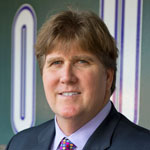To say that the Bill & Melinda Gates Foundation has made a difference in this world is a bit like saying McDonald’s has served a lot of hamburgers to the people who live in it—that is, it is a foregone conclusion that the words “Bill and Melinda Gates” and “philanthropy” are pretty much synonymous. Established by the eponymous spectacled Microsoft founder and his wife nearly 20 years ago, the foundation is, to date, the largest private nonprofit in history, including the time before something called a nonprofit ever existed.
Getting to Know
Connie Collingsworth
Walk us through your first day on the job as the first and only in-house lawyer at the foundation?
I have a distinct memory about that day. It used to be that on Monday mornings we’d have a bit of a war room meeting, where the people who were leading the foundation would talk about what was planned for the week. It just so happened that my first Monday morning followed a trip that had been taken by Bill Gates Sr. and President Carter. The purpose of the discussion, in part, was for them to report on how the trip had gone, which included learning about the eradication of guinea worm and other global health issues in Africa that the foundation was interested in. So that was a “Welcome to the foundation.” It gave me a pretty good taste of what life has been like ever since.
In terms of the foundation’s culture and the day to day, how big of an impact do Bill and Melinda themselves make?
It’s a family-run foundation. The Gates family—Bill and Melinda and Bill Sr., as well as Warren Buffett—run the foundation, and their personality is reflected in how it’s managed and the decisions that are made. Bill and Melinda are very intimately involved, setting the high-level strategic direction for the foundation. They’re also relatively available to the whole foundation. Even though it’s grown to the size of 1,100 people, it’s still a family foundation.
What do you feel you’ve learned from them?
They’re incredibly committed and passionate individuals, amazing in their commitment to the issues. Bill is astounding relative to how much he reads and invests in understanding the technical details about everything we’re doing. Melinda showed leadership in her recent work on the Family Planning Summit that was held this summer in London and focused on making contraceptives available in the developing world. Both of their work at the foundation is very inspiring in a lot of ways.
And for you, personally—looking back over the last 10 years, what are some major milestones for you? What stands out?
I would say the most significant deal of my whole career was working on the pledge from Warren Buffet to the foundation of 10 million shares of Berkshire Hathaway Inc. stock. It was a very simplistic pledge consistent with how Warren is in making things straightforward. But the implementation of the pledge was actually fairly complex from a securities and tax perspective. It ended up being the equivalent of a $31 billion asset deal, where we had to structure the foundation into two different entities and do a lot of work to make sure that it could be implemented very easily without any issues getting triggered. It took quite a bit of time, but it would be, by far, something I’m probably the most proud of getting to work on during my time at the foundation.
The organization was first formed in the hazy gray of Seattle’s December in 1994. With an initial stock gift of $94 million, the William H. Gates Foundation—named for Bill’s father, who cochairs the foundation today—began moving to distribute money to charitable causes that the Gateses cared about. After merging with another of Bill and Melinda’s philanthropic entities, the Gates Learning Foundation, in 2000, the funding organization as we know it today coalesced. Since then, the Bill & Melinda Gates Foundation has catalyzed widespread innovation in three specific areas: global development, global health, and US education, funding $4.4 billion in grants in 2011 alone to grantees in regions as far-flung as the US Pacific Northwest, where the foundation is headquartered; China; Africa; and India.
Despite massive financial resources, the foundation was still just a start-up in 2000. That’s how Connie Collingsworth, the foundation’s general counsel, remembers it. She came on board in 2002 as the foundation’s first in-house lawyer, and her to-do list would have matched that of any other family-run start-up company. “There was no contracts database. There was no paralegal. There were no policies. There was no intellectual-property policy.” She pauses. “There really was a lot to do. Just because it had $20 billion didn’t make it unique in that way.”
Before coming to the foundation, the content of Collingsworth’s legal background couldn’t have been more different. She had spent the previous 20 years working as a corporate securities lawyer for the large Seattle-based firm, Preston Gates & Ellis (K&L Gates today). “My practice was focused on business corporate work, primarily doing mergers and acquisitions for small and midsized companies, with more specialty in private equity work,” Collingsworth says. “Over that 20-year span it ranged from doing private-equity deals, venture capital, real-estate syndicated partnerships, and even—at the time that I left—doing hedge-fund formation. My practice would follow and try to stay up with whatever was hot in that area at the time.”
Although she was one of the first lawyers on the West Coast to begin doing hedge-fund formation work, Collingsworth was happy at her firm and had plenty of clients. But after two decades, her work had become to feel more routine. Some colleagues who represented the Gates Foundation doing tax work suggested the open position for a general counsel, and there wasn’t an ounce of doubt that this was the career move Collingsworth wanted to make. “I put my résumé together immediately,” she says, “because I saw what they saw—which is that there was going to be an opportunity to be part of something that was really historic.”
At the Gates Foundation, hedge funds became health organizations trying to rid the world of polio. Venture capital funds became the Alliance for a Green Revolution in Africa. But beyond those differences, Collingsworth’s business background prepared her better than one might expect. First, she had already experienced the vast range of legal questions an in-house general counsel might have to answer while working at Preston Gates & Ellis, where she preferred small and midsized companies. “I liked working directly with the executives and founders,” she says. “It was fun to work with companies that didn’t already have an in-house counsel, as I served basically as their outside general counsel—their go-to lawyer—and would coordinate within my large law firm all of their legal needs. So I wouldn’t necessarily be the expert on human resources, but any questions the company had that were of a legal nature would come to me. I would get the answer or the expert they needed within the firm, and oftentimes would translate or convey that information or be part of the solution. It gave me a lot of depth of experience to serve as general counsel as I have at the foundation.”
As a corporate business lawyer, the best part of Collingsworth’s job was working creatively within the structure and rules at hand and coming up with a solution. “That approach has been extremely useful at the foundation as well, because we’re basically doing different kinds of business arrangements; when we give money away, we are doing collaborations and partnerships, elements that are very similar to joint ventures or making investments.”

There were certainly challenges. Collingsworth had never done tax-exempt work before, requiring her to learn an entirely new area of law. But she wasn’t a stranger to nonprofits, having started one herself in 1995—the French American School of Puget Sound, a full-immersion French language school, which currently has 380 students K-8. Plus, despite that initial to-do list being long, Collingsworth has had the opportunity to create systems and policies from scratch, some of which have become known throughout the wider community of which the Gates Foundation is part. For example, global access. It is a concept Collingsworth’s legal team created, which requires grantees and partners who receive funding to make a commitment to make the products, including intellectual property and research results, widely available in the developing world at an affordable price. Global-access commitments also apply to collaborations with for-profit entities, who are allowed to sell whatever they develop with the help of the foundation—a groundbreaking diagnostic tool, for example—at a profit in the developed world, as long as the product is made available in the developing world consistent with the foundation’s charitable objectives.
Working in a place like the Gates Foundation, it would be difficult not to be inspired. One of the foundation-funded issues that Collingsworth most deeply cares about is financial services for the poor, especially women. “There’s a lot of research that shows if you give women tools with respect to savings and access to money—using tools like microloans and microlending—that they will do more with respect to making sure their children are fed and families are stable and empowered,” she says. Collingsworth sits on the board of Women’s World Banking, a New York-based nonprofit and international microfinance network with a focus on empowering women in the developing world.
Although she was once the Gates Foundation’s sole lawyer, Collingsworth has built up a team of 30 in the last decade. The team is sculpted to reflect the precise areas the Gates Foundation is growing into. As the foundation got into software for education efforts in the United States, Collingsworth added lawyers with copyright experience. As offices opened in London and Africa, she hired experts in international advocacy. As more work was being done with pharmaceuticals, she nabbed lawyers who had represented big pharma and had experience with clinical trials. Collingsworth herself has moved more and more into a managerial role—one she today takes seriously as her main task. One of her stated values for the legal team is that they are solution-oriented—that her department says yes first, and then finds a way to make it happen—a fairly unique reputation for lawyers, who are commonly counseled for risk-mitigation. “My lawyers don’t say no,” Collingsworth says proudly. “They really don’t. We only want to do good things. There’s usually a way to make it happen.”

